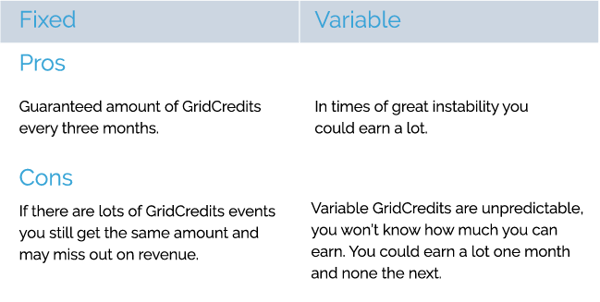Reposit GridCredits: Should you choose fixed or variable?

Did you know there are two types of GridCredits?
Ever heard of GridCredits? If you have a solar battery with Reposit, you can reduce your power bill by earning GridCredits through participating electricity companies, but what are they and did you know there are different types?
What are GridCredits?Reposit has partnered with electricity companies to offer you GridCredits, so you can get financially rewarded for helping the grid and get the best value from your solar battery system.
GridCredits are credits on your electricity bill that are additional to your solar feed-in tariff.
If you join a GridCredits electricity plan, these companies will pay you GridCredits in exchange for your solar battery providing some of your stored electricity (when requested) to help out the grid.
How do GridCredits work?
On hot summer days when everyone is cranking up their air conditioner, electricity companies need to meet our energy demands. If we’re all using lots of energy, we need to make sure there is lots of energy being created.
Sometimes there is a shortfall of electricity supply, and during these events participating electricity companies can activate your battery to bring stability to the grid and help prevent blackouts. The best thing is that they’ll pay you GridCredits® for providing this service, in addition to your solar feed-in-tariff. Simple.
In addition to lowering your bill, let’s not forget that GridCredits will help Australia to displace dirty generators that would otherwise provide the same service, and help maintain downward pressure on electricity prices in general.
Now you have the basics, there are different types of GridCredits, fixed and variable. Like fixed and variable home loans, there are benefits and disadvantages to both.
What’s the difference between fixed and variable GridCredits?
Fixed GridCredits means you earn a guaranteed amount of GridCredits® every three months for letting your electricity company activate your solar battery at certain times when the grid could use the help. Currently, fixed GridCredits plans are available through Powershop in Victoria, New South Wales, and South East Queensland*.
As you might expect, Variable GridCredits are less predictable. They happen when we’re all using lots of energy or when the electricity market price spikes. How many you can earn depends on the area you live in and how much electricity is needed in your area.
But when electricity demand is high you can earn an impressive 100c per kWh. This is well above even the best solar feed-in-tariff. Currently variable GridCredits plans are available through Diamond Energy in South Australia, Victoria, New South Wales, and South East Queensland and Simply Energy (ACT only).
So what are the pros and cons of fixed and variable GridCredits?

Choosing the right GridCredits plan for you
Although it would be ideal to provide a ‘one size fits all’ answer to the ‘fixed versus variable’ question, the reality is that the choice of which GridCredits plan you should choose should be determined by your situation, own financial goals and priorities. You need to take into account how your family uses energy and how much energy you generate and store in your solar battery.
To earn GridCredits® you need to be on an electricity plan with one of our partner electricity companies:
It’s time to look forward to your power bill with GridCredits. If you already have a Reposit solar battery system you can get free advice about which GridCredits plan would suit your needs, if you don’t have a Reposit solar battery system yet get in touch.
